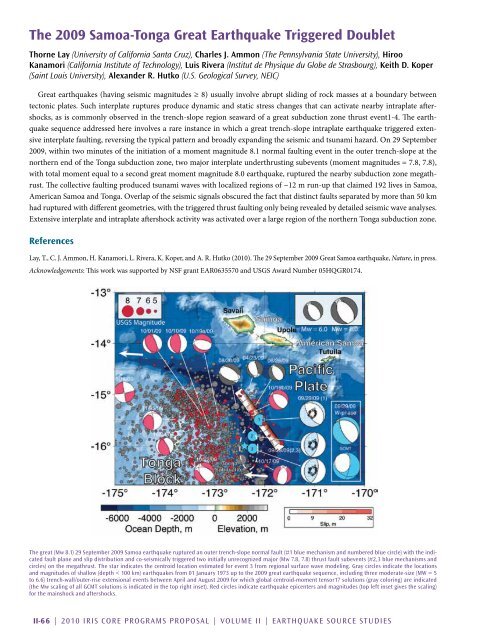Download Volume II Accomplisments (28 Mb pdf). - IRIS
Download Volume II Accomplisments (28 Mb pdf). - IRIS
Download Volume II Accomplisments (28 Mb pdf). - IRIS
Create successful ePaper yourself
Turn your PDF publications into a flip-book with our unique Google optimized e-Paper software.
The 2009 Samoa-Tonga Great Earthquake Triggered Doublet<br />
Thorne Lay (University of California Santa Cruz), Charles J. Ammon (The Pennsylvania State University), Hiroo<br />
Kanamori (California Institute of Technology), Luis Rivera (Institut de Physique du Globe de Strasbourg), Keith D. Koper<br />
(Saint Louis University), Alexander R. Hutko (U.S. Geological Survey, NEIC)<br />
Great earthquakes (having seismic magnitudes ≥ 8) usually involve abrupt sliding of rock masses at a boundary between<br />
tectonic plates. Such interplate ruptures produce dynamic and static stress changes that can activate nearby intraplate aftershocks,<br />
as is commonly observed in the trench-slope region seaward of a great subduction zone thrust event1-4. The earthquake<br />
sequence addressed here involves a rare instance in which a great trench-slope intraplate earthquake triggered extensive<br />
interplate faulting, reversing the typical pattern and broadly expanding the seismic and tsunami hazard. On 29 September<br />
2009, within two minutes of the initiation of a moment magnitude 8.1 normal faulting event in the outer trench-slope at the<br />
northern end of the Tonga subduction zone, two major interplate underthrusting subevents (moment magnitudes = 7.8, 7.8),<br />
with total moment equal to a second great moment magnitude 8.0 earthquake, ruptured the nearby subduction zone megathrust.<br />
The collective faulting produced tsunami waves with localized regions of ~12 m run-up that claimed 192 lives in Samoa,<br />
American Samoa and Tonga. Overlap of the seismic signals obscured the fact that distinct faults separated by more than 50 km<br />
had ruptured with different geometries, with the triggered thrust faulting only being revealed by detailed seismic wave analyses.<br />
Extensive interplate and intraplate aftershock activity was activated over a large region of the northern Tonga subduction zone.<br />
References<br />
Lay, T., C. J. Ammon, H. Kanamori, L. Rivera, K. Koper, and A. R. Hutko (2010). The 29 September 2009 Great Samoa earthquake, Nature, in press.<br />
Acknowledgements: This work was supported by NSF grant EAR0635570 and USGS Award Number 05HQGR0174.<br />
The great (Mw 8.1) 29 September 2009 Samoa earthquake ruptured an outer trench-slope normal fault (#1 blue mechanism and numbered blue circle) with the indicated<br />
fault plane and slip distribution and co-seismically triggered two initially unrecognized major (Mw 7.8, 7.8) thrust fault subevents (#2,3 blue mechanisms and<br />
circles) on the megathrust. The star indicates the centroid location estimated for event 3 from regional surface wave modeling. Gray circles indicate the locations<br />
and magnitudes of shallow (depth < 100 km) earthquakes from 01 January 1973 up to the 2009 great earthquake sequence, including three moderate-size (MW = 5<br />
to 6.6) trench-wall/outer-rise extensional events between April and August 2009 for which global centroid-moment tensor17 solutions (gray coloring) are indicated<br />
(the Mw scaling of all GCMT solutions is indicated in the top right inset). Red circles indicate earthquake epicenters and magnitudes (top left inset gives the scaling)<br />
for the mainshock and aftershocks.<br />
<strong>II</strong>-66 | 2010 <strong>IRIS</strong> Core Programs Proposal | <strong>Volume</strong> <strong>II</strong> | Earthquake Source Studies
















